|
Shooting the X Games
by Vivid Light Staff
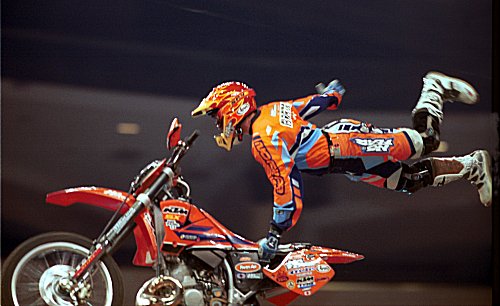
|
This is the first installment in our "pro
series" where we will go out ourselves or with a professional
photographer to give you a feel for what his or her job is really
like. |
I think every photographer who enjoys watching sports has wondered what it's like to actually be one of the photographers on the sidelines, in the dugout, or down in the photo pit. You see them with their pro cameras and amazingly large lenses and think that it must be a great way to make a living. But what is it really like?
Coincidentally, the X Games came to Philly just as we were planning to shoot our editorial on big-gun telephoto lenses. And, the nice folks at ESPN hooked us up with photo passes to cover the games and shoot our article.
The X Games were born in 1995 and were originally known as the Extreme Games. Unlike traditional "stick and ball" sports, the X Games were the brainchild of the ESPN sports network. ESPN still runs and controls the games.
At the first extreme games, 198,000 spectators turned out at locations in Rhode Island and Vermont to watch events such as windsurfing, bungy jumping, and mountain biking. In 1996 the Extreme Games officially became the X Games. That year they began to look more like the games today. Bicycle stunt riding, skateboarding, and in-line skating moved to the fore as the Games most popular events. '96 also saw the first X Games international exhibition in Shanghai and the first Winter X Games at Big Bear Lake, California.

Now the games have grown up. At the original games the athletes were just men and women who were already doing this stuff. They simply showed up and did it in front of the cameras. Now competitors make their living riding skateboards and dirt bikes, and stars like Tony Hawk have their own video games. It would be an understatement to say the games have been a tremendous success, almost 235,000 spectators turned out for this year's games in Philadelphia.
A week prior to the start of the games we went over to Philadelphia's First Union Center to pick up our press credentials and media kit for the games. Up until that point we were getting most of our information from
ESPN's Website on events and scheduling. When we got to the FU center (as its called locally) we were directed to a set of stairs leading into the bowels of the stadium (cool!). When we got down to the floor level we were given our media kits and photo badges and were told the printer had made a mistake and that we'd need to get new badges issued when we came in for media day the following Thursday. There would be a complimentary lunch, a tour of the facilities, more information on the games, and a chance to do some preliminary shooting during practice that day.
When we arrived on Thursday we were directed to a different entrance by a volunteer who didn't seem to know what was going on. Neither did any of the stadium staff we talked to. Finally a security guard directed us to the balcony at the top of the stadium where we found some ESPN folks, press releases, and a lot of info on the host city. We were assured that, yes there was a mistake with the badges, but it didn't affect our badges and no one seemed to know anything about facility tours. So, badges in hand we headed downstairs and sent our photo assistant out to the truck to retrieve our gear. But when we arrived down on the event floor, gear in hand, we were told that we had the wrong badges and that we needed to go to security. Security then directed us back up to the balcony. So with what seemed like 100 lbs of gear on our backs we headed back upstairs. This time we received the correct badges and, just over an hour after arriving, we were finally admitted onto the floor for the first time.
Why so much gear you may be wondering? Two reasons actually. First, we really weren't sure what to expect on the first day so we severely over packed. The second was that we were carrying four big zooms, two camera systems, and a normal compliment of lenses and flashes for two photographers. All of which added up to quite a bit of weight - hence our need of a photo assistant to help with the gear. Were I to go back and cover the games tomorrow as working photographer I would throw two bodies over my shoulder, one with and 80-200 f2.8 zoom, the other fitted with a 300 f2.8 zoom, and good quality flash heads on both cameras. I'd drop a 24 or 28mm prime in my pocket and feel like I was ready for anything.
 A large banner covered the end of the tunnel leading to the event floor. As I pulled the banner aside to step through, a BMX rider sailed by only feet in front of me and soared off a ramp high into the air - kicking his bike sideways before landing on the next ramp and sailing skyward again. I looked up and around the stadium and I have to admit it was an adrenaline rush being down on the floor.
A large banner covered the end of the tunnel leading to the event floor. As I pulled the banner aside to step through, a BMX rider sailed by only feet in front of me and soared off a ramp high into the air - kicking his bike sideways before landing on the next ramp and sailing skyward again. I looked up and around the stadium and I have to admit it was an adrenaline rush being down on the floor.
Evidently it was enough of an adrenaline rush to make my photographic brain shift into neutral. The plan had been to pop off a roll of slide film to get a feel for the color temperature of the stadium lights so we could make some intelligent choices regarding film and filters for shooting the games. Unfortunately I was too busy thinking "hey this is pretty cool" and I forgot the basics - like checking all my camera settings before I started shooting. Unfortunately the camera was set up for a two stop push. The result was that I fired off two rolls of slide film, that when processed normally, were two stops underexposed (insert the sound of my palm slapping my forehead). All was not lost as we could make out that the indoor lights were daylight balanced but the urge to kick myself was quite strong.
 The first day of actual competition three of us arrived at the stadium, Chuck, Myself, and our photo assistant Brian. Traffic was a bear and I have to admit feeling a little superior as I flashed my badge and was immediately admitted into the reserved parking area (and didn't have to pay the outrageous parking fee).
The first day of actual competition three of us arrived at the stadium, Chuck, Myself, and our photo assistant Brian. Traffic was a bear and I have to admit feeling a little superior as I flashed my badge and was immediately admitted into the reserved parking area (and didn't have to pay the outrageous parking fee).
We spent about an hour walking the X-Games outdoor carnival, shooting the locals who were using the skateboard ramps and the outdoor bike riding park. As the clock marched towards the first event it was getting hot and there was precious little shade to be had.
The first event we were shooting was the Moto-X. After navigating several credential checks, we walked back along the outside wall to the far end of the track and took up residence just down the wall from the I-Max film crew. It was about an hour before the start of the event. We reasoned that we'd be in a good location to shoot the bikes as they flew off the ramps coming straight at us. What we didn't count on was just how hot it would get out there or the fact that we wouldn't be able to see which ramp the bikes were coming over until they were already in the air. That meant that we had to be VERY fast on the draw as the bikes are only airborne for seconds. During those few seconds the rider gets off the bike in mid-air, does a stunt, and hops back on the bike. Hopefully before it hits the ground. These guys have major cajones.
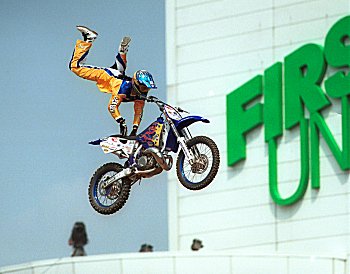 A trick I picked up partway through the event was to watch the I-Max guys. They were wearing headphones and evidently had a spotter since they always seemed to know what ramp the riders were coming off of. I'd glance sideways at the I-Max crew when they set up the shot, quick pan to that ramp, find the rider as he came off the top, focus and fire!
A trick I picked up partway through the event was to watch the I-Max guys. They were wearing headphones and evidently had a spotter since they always seemed to know what ramp the riders were coming off of. I'd glance sideways at the I-Max crew when they set up the shot, quick pan to that ramp, find the rider as he came off the top, focus and fire!
At the end of the event, three dusty, tired, sweaty, and probably smelly photographers dragged themselves inside to suck down bottles of water before heading down to the event floor to shoot the skateboarders and in-line skaters. Since these were preliminaries the photo pit wasn't crowded. You could walk up the rail, find a shooting position, then reorient yourself somewhere else to try and work a different angle. The ability to try different angles would pay off when the finals rolled around. Then the photo pit was elbow to elbow at the rail and it really paid to know where you needed to be for the best shot.
I often wondered when you see all those photographers packed in tight at these events how "friendly" the jockeying for position is. I found out that, at least in this case, it was very friendly. Everyone gave their neighbors as much room as possible and accidental bumps were always followed up by "sorry".
The tough part about this kind of shooting is that you're limited to a narrow area. That means that you can't control your backgrounds, which include crowds, overhead lights, and other skaters. F2.8 lenses help to isolate your subject from the background to some extent but when you look at the results you quickly see that they're not a cure all. A number of otherwise good shots would wind up in the reject pile because the backgrounds were simply too busy.
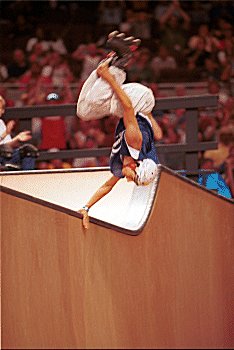 These lenses had unique properties that seemed to defy the laws of physics - as the day wore on their weight was apparently increasing! 300 f2.8 lenses are big heavy lenses and you can forget about using a tripod when shooting this kind of action.
These lenses had unique properties that seemed to defy the laws of physics - as the day wore on their weight was apparently increasing! 300 f2.8 lenses are big heavy lenses and you can forget about using a tripod when shooting this kind of action.
Something else that was becoming apparent by this time: these types of events, with their fast pace, sudden direction changes in both the horizontal and vertical planes, and fast moving subjects, were a real challenge for these lenses. Outdoors we had noticed that some of the lenses weren't focusing fast enough to capture all of the action (see text on the lenses), and that the tracking systems sometimes had problems acquiring the riders.
Once indoors, in lower light, these problems became far more pronounced. We had switched from the ISO 100 slide film that we were shooting outdoors to ISO 400 negative film indoors figuring that the higher speed would give us faster shutter speeds and be more forgiving if the meter was fooled slightly by the changing lighting. During one event I measured a stop and a half difference between parts of the skateboard vert ramp and the light above the ramp where the skaters were doing their flips. But even using 400 speed film and f2.8 apertures we were getting shutter speeds in the 1/60th to 1/100th of a second range. Would this be fast enough to freeze the skaters action? Not having experience in shooting this kind of event we weren't sure.
 Another complication was that one of the ramps, actually a large dirt hill, was right in front of the photo area between us and the skateboard vert ramp. That meant that when tracking the riders from the top of one side of the ramp across to and back up the other side they would pass behind the dirt mound and that the autofocus system would have to reacquire them on the other side. The Minolta system wasn't able to do this cleanly and would close focus on the ramp. The best way to deal with this was to let up on the shutter button as the ramp passed into the viewfinder then press down again as you picked them up on the other side. This meant that the focus plane of the lens was close to correct for the rider and the camera could reacquire him easily. Let it focus on the ramp and the camera wouldn't be able to reacquire the fast moving rider until he'd already done his trick and was heading back down the ramp towards the hill again. The Nikon system did a much better job of ignoring objects that passed between the rider and the photographer. It was sometimes fooled but most of the time it was able to continue to track the rider. Another complication was that one of the ramps, actually a large dirt hill, was right in front of the photo area between us and the skateboard vert ramp. That meant that when tracking the riders from the top of one side of the ramp across to and back up the other side they would pass behind the dirt mound and that the autofocus system would have to reacquire them on the other side. The Minolta system wasn't able to do this cleanly and would close focus on the ramp. The best way to deal with this was to let up on the shutter button as the ramp passed into the viewfinder then press down again as you picked them up on the other side. This meant that the focus plane of the lens was close to correct for the rider and the camera could reacquire him easily. Let it focus on the ramp and the camera wouldn't be able to reacquire the fast moving rider until he'd already done his trick and was heading back down the ramp towards the hill again. The Nikon system did a much better job of ignoring objects that passed between the rider and the photographer. It was sometimes fooled but most of the time it was able to continue to track the rider.
By the end of the night a couple of things were obvious. We'd been shooting for almost 10 hours straight handholding these heavy lenses which obviously weighed about 300 lbs each while running on bad lunch meat sandwiches and soda from the press room. It was time for a beer and a sit down to discuss what we'd learned about these lenses.
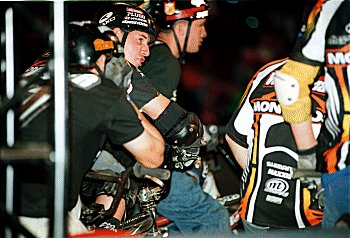 One thing that was obvious was so much of this kind of shooting is timing. Our constant switching of equipment for our evaluation made it difficult to get our timing down. We felt that we'd get better performance out of any of these lenses if we were using them every day and had the opportunity to learn their quirks and timing requirements.
One thing that was obvious was so much of this kind of shooting is timing. Our constant switching of equipment for our evaluation made it difficult to get our timing down. We felt that we'd get better performance out of any of these lenses if we were using them every day and had the opportunity to learn their quirks and timing requirements.
Fast-forward a couple of days. By the time we got to the skateboard and BMX finals our personal timing and our familiarity with the lenses had improved considerably. We'd had a chance to look at a lot of shots from each lens and we'd each found our favorite. I decided to just use one lens for the skateboard event and was pleasantly surprised with how much I was able to dial-in compared to the previous days of constantly switching lenses. Our film experiment that day was less pleasing. Coming on the heals of last month's Provia 400F review I got the bright idea to try shooting slide film (Provia 400F) pushed one stop to 800 just to see what I'd get. Given the narrow exposure latitude of slides this was a risk, but I felt I had a good bank of images already for the magazine so lets give it a try.

The result was a lesson in why the guys who do this for a living don't shoot slide film. Shots on some parts of the vert ramp looked great. As a matter of fact the cover shot was done with Provia 400 pushed to 800 and it's so sharp I can make out the individual hairs on the rider's leg. But on other parts of the ramp the light changed. I had some otherwise great shots that were unusable because the highlights on the rider's skin were completely blown out. These problems hadn't shown up when using Fuji Press 400 because the wider exposure latitude of negative film makes it more forgiving. Lesson learned.
Throughout the event I also tried to focus on the athletes and their equipment away from the main event. These little details help to tell the story of the event, the athletes, and the crowd. They can also be tough to visualize if you become too focused on the event floor.
For most of these events, the athlete's have several runs. So I would focus on getting some footage of each athlete during their first run. During the second runs I would look along the edges of the competition for interesting details away from the action. Then during the final run, when they often did their most spectacular stunts, I would again focus on the athletes,
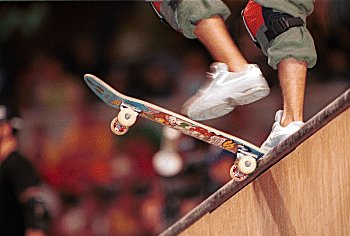 I was surprised to find the initial awe and adrenaline I felt walking onto the floor during that first practice had passed quickly. Before long it was as if I was going to a job every day. A cool job yes, but just another job - much of which quickly became routine. Things like badges that seemed neat at first just became a tool that allowed you to move more quickly behind the scenes.
I was surprised to find the initial awe and adrenaline I felt walking onto the floor during that first practice had passed quickly. Before long it was as if I was going to a job every day. A cool job yes, but just another job - much of which quickly became routine. Things like badges that seemed neat at first just became a tool that allowed you to move more quickly behind the scenes.
In the end we were happy with the results. We got a lot of shots we were pleased with. We got a new respect for the folks who do this for a living. And, at least for a little while we satisfied the Walter Mitty in our soul and found out a little of what it's really like to be "one of those guys."
 Subscribe to
Vivid Light
Subscribe to
Vivid Light
Photography by email
|
|


 

|